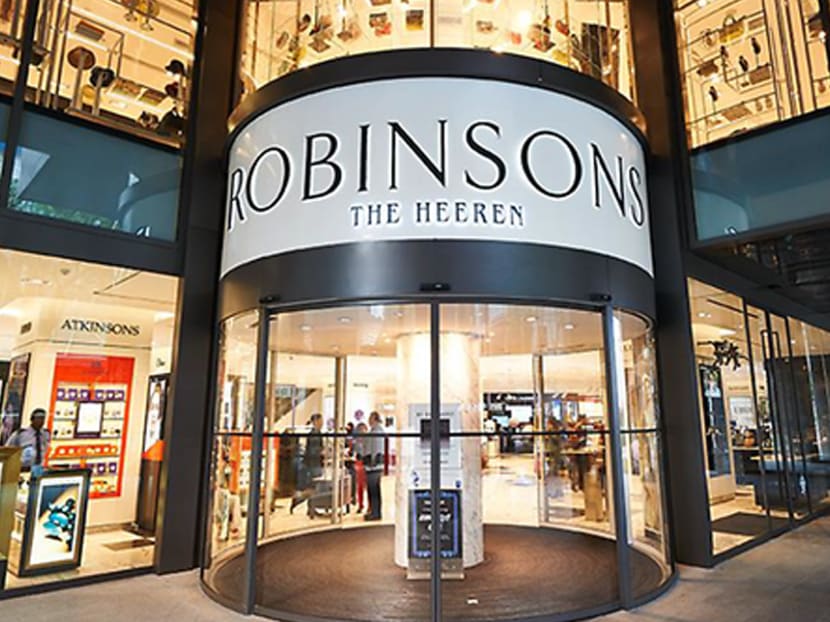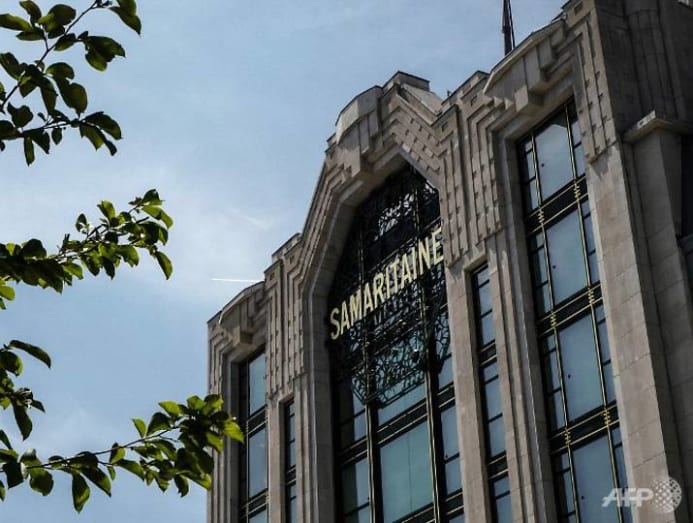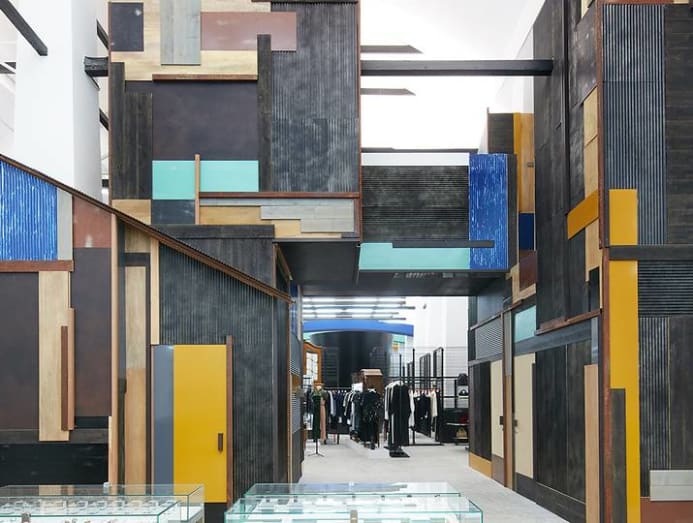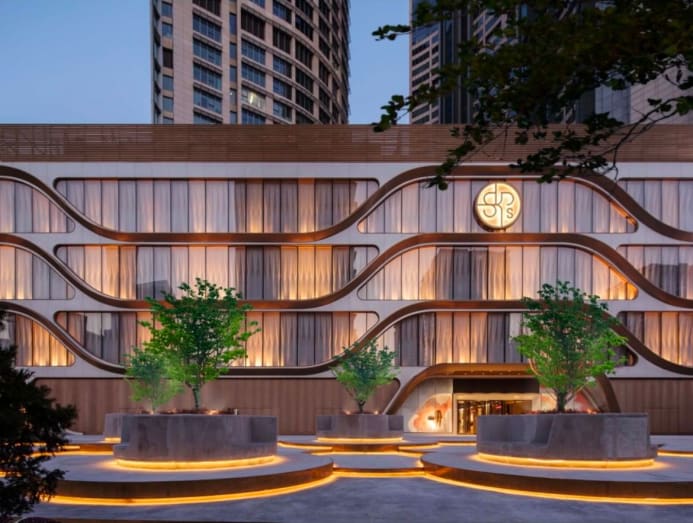What does the future hold for department stores? Reinvention, repurposing?
Sure, department stores as we’ve known them might not survive. But their future could be far more interesting. As one writer points out, empty retail units make perfect spaces for art, theatre, workshops or even retirement homes.

The former Robinsons store at The Heeren. (Photo: Robinsons)
When the first great department stores opened in Paris and the US in the late 19th century, they were like nothing that had been seen. There were cafes, restaurants and smoking rooms, fountains and winter gardens, luxury goods that customers could browse without being bothered by staff.
There were even ladies’ lavatories: Women could spend an entire day in town in safety and without moral opprobrium. A glimpse of lifestyles that had previously been available only to the elite was now on view to almost anyone who strolled in.
READ> Livestream sales of luxury items are popular in China, but not Singapore. Why?
It’s difficult to reconcile all this with the dying department stores that now loom, unloved, in cities, towns and suburban malls. A walk through central London takes you past the dead hulk of Debenhams on Oxford Street and the soon-to-close former Army & Navy in Victoria. Edinburgh has lost Jenners.
It’s perhaps even worse in the US: The ailing JC Penney has closed more than 160 stores, Neiman Marcus has been battling with bankruptcy and restructuring, and other once-mighty names are in trouble. One estimate suggests that 800 US department stores may close during the next five years – roughly half the remaining mall-based total.
READ> Robinsons Singapore is back – as an online department store
The pandemic retail apocalypse has been written about extensively, but what about the architectural losses? While Selfridges has recently been granted a licence to host weddings at its swaggering Edwardian Oxford Street headquarters, as well as experimenting with pop-ups and opening a vegan butcher, Marks and Spencer is demolishing some of its landmark stores and replacing them with generic mixed-use buildings that have little of the flair of the originals.
Gems such as the streamlined 1930s Debenhams in Taunton, south-west England, face uncertain futures. The trend appears to be to let these buildings go: Just as the retail world has moved on, these cavernous carcasses should be knocked down or gutted to make room for something else.
READ> Will department store shopping ever be the same in the post-pandemic era?
Is this the only option? As well as being architecturally significant, these remarkable buildings are an incredible resource. They may be desolate now, but myriad fascinating futures are possible.
Take Paris’s La Samaritaine, a grand, 70,000 sq m complex of Art Nouveau and Art Deco buildings in the first arrondissement, which opened in 1870 and grew to become one of the architectural wonders of its age.

After a lengthy and controversial redesign process, it finally reopened this year, wrapped in rippling, translucent glass designed by the Japanese architects SANAA. A luxury hotel, a remodelled store and offices are part of the scheme; more surprisingly, perhaps, it also includes 96 social housing units and a nursery – an impressive intervention in a sensitive historic site.
There are more experimental possibilities, too. Kathryn Bishop of strategic consultancy The Future Laboratory points to projects where department stores have been converted into retirement homes or sheltered accommodation.

The Folkestone senior-living community in Wayzata, Minnesota, is a former mall, its brick-faced blocks offering a simulacrum of urbanity. “Many Americans over 55 don’t want suburban bungalows but sidewalks and shops,” she said. “We might see health and wellbeing much more integrated in the streets.”
Another possibility is culture. Might not empty retail units make perfect spaces for art, theatre, workshops? There are big windows for studios and display, and deep floor plates for galleries. Museums are keen not to be perceived as exclusive – what better way to present their treasures to the public than on high streets? Or perhaps spaces in less residential areas could transform into nightclubs, which have been shut down by the pandemic. After all, nightlife always appropriates spaces conceived for other uses.

What went wrong with traditional department stores in western cities? It seems obvious to blame the huge growth in online shopping – accelerated by the pandemic – but Vicki Howard, an academic at the University of Essex and the author of From Main Street to Mall: The Rise and Fall of the American Department Store, identifies a longer, sorrier history. This reaches back to the late 20th century, when debt-driven expansion enabled major retail players to swallow up local brands, creating identikit stores that were shadows of their former selves.
“Businesses took every opportunity to strip away those costly amenities which had made them luxurious – the service, the training of the staff,” she said. “Then they expanded into the suburbs, where they built windowless boxes, maximising floor and display space in the middle of a car park. The materials they used didn’t stand the test of time and they ended up as strip malls.”
This shift from city centres was faster in the US, but it hasn’t been entirely one-way, Howard adds: In the past decade, as downtowns have been gentrified and revitalised, abandoned malls have been redeveloped too. The Mall of America in Minnesota, the country’s biggest, filled up some of its empty spaces with a large walk-in health clinic in 2019, a move that looks prophetic in light of COVID-19.
If the idea of the department store itself is to endure, it is going to have to change. For some, this might mean prioritising luxury. The success of London’s Dover Street Market, created by Comme des Garcons founder Rei Kawakubo and her husband Adrian Joffe in Mayfair, has established a model for the department store as a high-concept, high-design hang-out, closer to an art gallery than a shop and mixing streetwear with haute couture.

Dover Street Markets have now materialised in locations including Singapore, Tokyo, Beijing and LA. In New York, Roman & Williams’ Lafayette Street outlet offers antiques, crafts, art, dining and design in an upmarket interior which has something of the crowded luxury of the grandest 19th-century stores.
London-based architecture practice Sybarite is building a number of adventurous retail spaces in China, some repurposed from older structures. Sybarite’s stores recall the ambition of the golden era of Selfridges and the like – if not the aesthetic.
One project for the high-end store brand SKP-S brings sci-fi fantasy to central Beijing: A “Mars zone” features life-size model space vehicles, accommodation modules and immersive evocations of the Martian landscape; its snaking corridors look like something from Star Wars.
Sybarite co-founder Torquil McIntosh explains that Chinese consumers, once derided for copying western fashions, are now leading the way in retail. “The Chinese have understood that people just want to have fun, spend a day out and Instagram the hell out of everything,” he said. “Customers switch between their phones and the real environment and back every second.”

For other projects, the key will be location. Bishop identifies a phenomenon she refers to as “small box stores”. If the past few decades were dominated by suburban malls filled with huge DIY outlets, home-furnishing outfits and discount hypermarkets, many of these businesses have been trying to get back into city centres – “even Ikea”, Bishop pointed out.
The fact that so many of us have been working from home during the pandemic has had a revitalising effect on local high streets, with workers popping out to shops and cafes near where they live. Stores and big brands might have to come to us rather than expecting us to go to them.
Empty shops are usually seen as an indicator of economic blight but, looked at another way, they are spaces of opportunity. It will take subtle shifts in regulation and developers’ mindsets – away from relying on financially leveraged global brands paying assured rents.
It will also take engagement from local authorities and communities, committed to maintaining these distinctive and often historic structures on their streets. And it will need a new, nimble entrepreneurialism. Sure, department stores as we’ve known them might not survive. But their future could be far more interesting.
By Edwin Heathcote © 2021 The Financial Times



